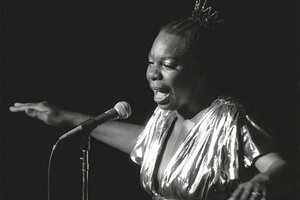'What Happened, Miss Simone?' takes too simplistic a view of the singer's life
'Simone' tries to canonize her as a sacrificial feminist icon crucified on the altar of America’s racism, which doesn't quite work, but the film does have mesmerizing clips of the singer performing.

Nina Simone performa at Avery Fisher Hall in New York in 1985.
Rene Perez/AP
I remember in college playing an old recording of Nina Simone singing “I Loves You, Porgy” and practically wearing out the grooves listening to it again and again. The emotional depth-dive of that performance was so profound that you had no choice but to stop everything and listen. It was Simone’s only Top 40 hit, from her 1959 debut album “Little Girl Blue,” but her entire musical career, fraught as it was, exhibited the same fearful power.
“What Happened, Miss Simone?,” directed by Liz Garbus and executive produced by Simone’s actress-singer daughter, Lisa Simone Kelly, attempts not only to portray Simone’s harrowing life but also to charge it with political meaning. (In addition to its theatrical release, Netflix, the film’s co-financier, will also offer the documentary.)
I think the film overreaches in casting Simone as a standard-bearer against racism and sexism, but it’s filled with mesmerizing clips from throughout her performing career as well as numerous interviews with Simone, both audio and on film. (She died in 2003.) There are also shockingly candid diary excerpts as well as testimonies from fellow musicians and assorted commentators, including Kelly and Simone’s ex-husband, the late Andrew Stroud, a former New York vice cop who allegedly brutalized the singer.
Simone, born Eunice Waymon – she lifted the name Simone from Simone Signoret when her singing career commenced – was a child prodigy. She grew up in segregated Tryon, N.C., where, at age 3, she was playing gospel hymns on the piano for her mother’s church choir. After a year at Juilliard, she was rejected by the Curtis Institute of Music in Philadelphia – she attributed this to racism – thereby voiding her dream of becoming the first black female classical concert pianist. She only became a singer because the nightclub gigs she took to make a living required it.
Her dusky, insinuating, jazzy-bluesy baritone is so singular that it could never be mistaken for anyone else’s. It’s a voice that comes through fire, and the implication, of course, is that her life did, too. The documentary bears this out. As the civil rights era, with all its violence and assassinations, came to the fore, Simone could no longer separate out her art from her indignation. “How can you be an artist and not reflect the times?” she asks in the film, and for her at least, there was no choice. Her 1964 song “Mississippi Goddam,” written in response to the killing in that state of Medgar Evers, and the killing of four black girls in a church bombing in Birmingham, Ala., was taken up as an anthem of the times. (She sang it in Selma, Ala., for 40,000 marchers.)
But Simone also suffered from what was eventually diagnosed as bipolar disorder, and although the movie doesn’t enlarge the point, it seems clear that her indignations were much more than politically based.
Simone needed, I think, a continual dose of rage to fulfill her artistry; she wasn’t interested in being a cheery pop singer or sexpot. Simone aligned herself with the most militant civil rights agitators, and the film takes a rather benign view of the thuggish Black Panther Party, and such moments as when she calls out “Are you ready to kill if necessary?” at one of her concerts. She was friends with Martin Luther King Jr. but pointedly told him, “I am not nonviolent.”
Simone’s rage undid her life and career for a time, until she began to stir again in the 1970s. There is an amazing clip of her comeback in 1976 in Montreux, Switzerland, where she walks out onstage with a feral intensity that was a main event all by itself. (At one point, at the piano, she sternly commands a departing audience member to Sit. Back. Down.) Her daughter makes the point that the Simone onstage and the woman offstage were essentially the same person. The emotional toll, not just on Simone but on those around her, including her daughter, was excruciating.
Garbus shows us the many agonizing aspects of Simone’s life but then, in the end, tries to canonize her as a sacrificial feminist icon crucified on the altar of America’s racism. This is too simplistic. It doesn’t make enough allowance for the demons tearing at Simone that had little to do with civil rights or being black. The heightened fascination with her life and career – a biopic starring Zoe Saldana is due out this year, as well as the documentary “The Amazing Nina Simone,” directed by Jeff L. Lieberman, and her songs have been covered by artists in a range of genres from Southern gospel to neo-funk – is no doubt encouraged by so much of the racial strife today that harks back to the ’60s. But it would be an injustice to Simone’s artistry to cast her in such sacrificial terms. The woman we hear singing “Sinnerman” or “I Loves You, Porgy” is no political icon. She’s a living, breathing human being ferociously engaged in her own sorrows. Grade: B+ (This film is not rated.)

